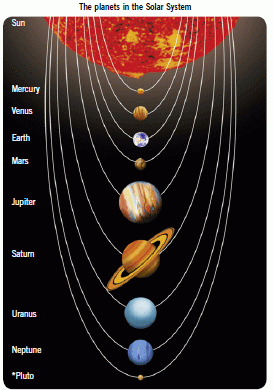The Solar System
The Solar System
The Solar System was formed over a very long time from clouds of gases and dust in space, about five thousand million years ago.
The planets orbit the Sun, which is the star at the centre of the Solar System. There are eight planets and Pluto which is a dwarf planet. Some planets are orbited by one or more moons. An object which orbits another is called a satellite. The Moon is a natural satellite of the Earth.

Asteroids are rocks, up to about 1 km in diameter, that orbit the Sun. These have been around since the formation of the Solar System. Most of these are between Mars and Jupiter. Jupiter is the largest planet and there is a large gravitational force towards it. This has prevented the formation of a planet between Mars and Jupiter, in the asteroid belt.
There are many comets. Some take less than a hundred years to orbit the Sun, while others take millions of years. They are made of ice and dust. Most have a nucleus of less than about 10 km, but this vapourises and becomes a cloud thousands of miles across when the comet is close to the Sun. Comets spend most of their time far from the Sun – much further away than the dwarf planet Pluto.
Meteors, or shooting stars, are caused by dust and small rocks, usually from a comet. When the Earth passes through this debris the rocks fall through the atmosphere. They heat up and glow. Any pieces that land on the Earth are called meteorites.
Near Earth Objects (NEOs) are comets and asteroids in an orbit that brings them close to the Earth. Some of them could one day collide with Earth. The craters on the Moon are evidence of collisions in the past. Craters on the Earth have been mostly eroded away.
Surveys by telescopes try to observe and record the paths (trajectories) of all NEOs. They can be monitored from Earth or by satellite. We can make sure that we have advance warning of a collision. The idea of deflecting a NEO using explosions is being considered. At present scientists are collecting information about the composition and structure of NEOs. The possibility of destroying one is still only in the planning stage.
This video explains more about our solar system
The Light Year
A light year is the distance light travels in a year.
Light travels through space, which is a vacuum, at 300 000 km/s. Light from the Sun arrives on Earth after about eight minutes. After a year, light from the Sun will have travelled a distance of: = 300 000 km/s × (the number of seconds in a year)
This distance is about 9.5 × 1012 m – about nine and a half million million kilometres. Distances to stars and galaxies are so large that we measure them in light years. The nearest star to Earth is the Sun. The second nearest is about four light years from Earth.
